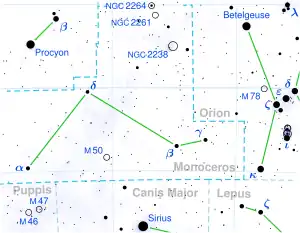 | |
| Observation data Epoch J2000.0 Equinox J2000.0 (ICRS) | |
|---|---|
| Constellation | Monoceros |
| Right ascension | 06h 14m 51.33367s[1] |
| Declination | −06° 16′ 29.1880″[1] |
| Apparent magnitude (V) | 3.96[2] |
| Characteristics | |
| Spectral type | K1.5IIIBa0.3[3] |
| U−B color index | +1.42[2] |
| B−V color index | +1.31[2] |
| Astrometry | |
| Radial velocity (Rv) | −4.8±0.7[4] km/s |
| Proper motion (μ) | RA: −4.69[1] mas/yr Dec.: −19.30[1] mas/yr |
| Parallax (π) | 6.55 ± 0.19 mas[1] |
| Distance | 500 ± 10 ly (153 ± 4 pc) |
| Absolute magnitude (MV) | -1.93[5] |
| Details | |
| Luminosity | 1021[5] L☉ |
| Surface gravity (log g) | 1.61[6] cgs |
| Temperature | 4,375[6] K |
| Metallicity [Fe/H] | −0.15[6] dex |
| Rotational velocity (v sin i) | 4.0[7] km/s |
| Other designations | |
| Database references | |
| SIMBAD | data |
γ Monocerotis, Latinised as Gamma Monocerotis, is a binary star[8] system in the equatorial constellation of Monoceros. Based upon an annual parallax shift of 6.55 mas,[1] it is located roughly 500 light years from the Sun. It can be viewed with the naked eye, having an apparent visual magnitude of 3.96.[2] Gamma Monocerotis is moving away from the Sun with a radial velocity of −5 km/s.[4]
This is an evolved K-type giant star with a stellar classification of K1.5 III Ba0.3.[3] The Ba0.3 suffix indicates this is a mild barium star, which means the spectrum displays abnormal abundance of s-process elements, including barium. These were deposited by an orbiting companion as it passed through the asymptotic giant branch stage. The companion is now a white dwarf star.[9]
It has reported companions B, at separation 53.7" and magnitude 13.1, and C, at separation 47.9" and magnitude 13.6.[10]
References
- 1 2 3 4 5 6 Van Leeuwen, F. (2007). "Validation of the new Hipparcos reduction". Astronomy and Astrophysics. 474 (2): 653–664. arXiv:0708.1752. Bibcode:2007A&A...474..653V. doi:10.1051/0004-6361:20078357. S2CID 18759600. Vizier catalog entry
- 1 2 3 4 Ducati, J. R. (2002). "VizieR Online Data Catalog: Catalogue of Stellar Photometry in Johnson's 11-color system". CDS/ADC Collection of Electronic Catalogues. 2237. Bibcode:2002yCat.2237....0D.
- 1 2 Hoffleit, D.; Warren, W. H. (1995). "VizieR Online Data Catalog: Bright Star Catalogue, 5th Revised Ed. (Hoffleit+, 1991)". VizieR On-line Data Catalog: V/50. Originally Published in: 1964BS....C......0H. 5050. Bibcode:1995yCat.5050....0H.
- 1 2 Gontcharov, G. A. (2006). "Pulkovo Compilation of Radial Velocities for 35 495 Hipparcos stars in a common system". Astronomy Letters. 32 (11): 759–771. arXiv:1606.08053. Bibcode:2006AstL...32..759G. doi:10.1134/S1063773706110065. S2CID 119231169.
- 1 2 Anderson, E.; Francis, Ch. (2012). "XHIP: An extended hipparcos compilation". Astronomy Letters. 38 (5): 331. arXiv:1108.4971. Bibcode:2012AstL...38..331A. doi:10.1134/S1063773712050015. S2CID 119257644. Vizier catalog entry
- 1 2 3 Wu, Yue; Singh, H. P.; Prugniel, P.; Gupta, R.; Koleva, M. (2010). "Coudé-feed stellar spectral library – atmospheric parameters". Astronomy & Astrophysics. 525: A71. arXiv:1009.1491. Bibcode:2011A&A...525A..71W. doi:10.1051/0004-6361/201015014. S2CID 53480665.
- ↑ De Medeiros, J. R.; Alves, S.; Udry, S.; Andersen, J.; Nordström, B.; Mayor, M. (2014). "A catalog of rotational and radial velocities for evolved stars". Astronomy & Astrophysics. 561: A126. arXiv:1312.3474. Bibcode:2014A&A...561A.126D. doi:10.1051/0004-6361/201220762. S2CID 54046583. Vizier catalog entry
- ↑ Eggleton, P. P.; Tokovinin, A. A. (September 2008). "A catalogue of multiplicity among bright stellar systems". Monthly Notices of the Royal Astronomical Society. 389 (2): 869–879. arXiv:0806.2878. Bibcode:2008MNRAS.389..869E. doi:10.1111/j.1365-2966.2008.13596.x. S2CID 14878976.
- ↑ Yang, Guo-Chao; et al. (January 2016), "Chemical abundance analysis of 19 barium stars", Research in Astronomy and Astrophysics, 16 (1): 019, arXiv:1602.08704, Bibcode:2016RAA....16...19Y, doi:10.1088/1674-4527/16/1/019, S2CID 14474857, 19.
- ↑ Mason, Brian D.; Wycoff, Gary L.; Hartkopf, William I.; Douglass, Geoffrey G.; Worley, Charles E. (2001). "The 2001 US Naval Observatory Double Star CD-ROM. I. The Washington Double Star Catalog". The Astronomical Journal. 122 (6): 3466. Bibcode:2001AJ....122.3466M. doi:10.1086/323920. Vizier catalog entry